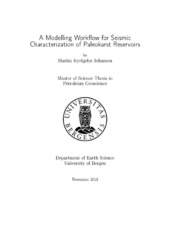| dc.contributor.author | Johansen, Martin Kyrkjebø | |
| dc.date.accessioned | 2018-12-14T16:01:50Z | |
| dc.date.available | 2018-12-14T16:01:50Z | |
| dc.date.issued | 2018-12-14 | |
| dc.date.submitted | 2018-12-13T23:00:02Z | |
| dc.identifier.uri | https://hdl.handle.net/1956/18765 | |
| dc.description.abstract | Karst is a type of landscape formed by dissolution of soluble rocks such as carbonates. Caves are common subsurface karst features and develop where water percolates through the host rock and creates cave-passages through dissolution. With time and burial, the cave-passages may collapse or fill in with sediments, but drill bit-drops indicating open cavities have been registered at large depths (up to 5 km). This type of reservoir has the potential of containing substantial hydrocarbon accumulations. The complexity of these carbonate paleokarst reservoirs makes it very difficult for interpreters to identify any clear characteristics in seismic sections. Therefore, a thorough investigation is needed to establish a guideline to help interpreters knowing what characteristics to look for and what they represent in terms of “real” geology. By performing seismic forward modelling of a paleokarst system, an understanding of the seismic of these types of reservoirs can be achieved. The representation of a paleokarst system can be obtained by building models from good paleokarst outcrops, from modern active cave systems or by developing generic models. To account for the range of heterogeneities common in paleokarst reservoirs, an implementation of a suitable rock physics model to compute the elastic properties, is essential. A sensitivity study of modelled seismic images with respect to various petrophysical conditions is best obtained by using an effective and robust modelling approach. A suitable option for such efficient seismic modelling approach is a Point-Spread Function based 2(3)D convolution method which is applied to the whole input model at once and has more realistic illumination and resolution effects compared to the standard 1D convolution method. This study demonstrates a modelling workflow relevant for seismic characterization of paleokarst reservoirs. The input models used in this work consist of an outcrop-based 2D model of a paleokarst structure located in the Franklin Mountains, Texas, and a 3D reservoir model representing a modern cave system called the Setergrotta cave, which is located near Mo i Rana, Norway. The comparison between different rock physics parameters added to the paleokarst models indicated that the pore geometry has a major influence on the seismic velocity, especially in low-porosity cases. The seismic forward modelling approach proved to be efficient and convenient in terms of providing sufficiently realistic seismic images, and therefore providing a good approach for testing and comparing various paleokarst reservoir conditions. | en_US |
| dc.language.iso | eng | eng |
| dc.publisher | The University of Bergen | en_US |
| dc.subject | paleokarst | eng |
| dc.subject | Seismic modelling | eng |
| dc.subject | PSF | eng |
| dc.subject | seismic characterization | eng |
| dc.subject | paleokarst reservoirs | eng |
| dc.subject | Seismiske metoder | nob |
| dc.subject | Seismikk | nob |
| dc.subject | Seismisk analyse | nob |
| dc.subject | Karst | nob |
| dc.title | A Modelling Workflow for Seismic Characterization of Paleokarst Reservoirs | en_US |
| dc.type | Master thesis | |
| dc.date.updated | 2018-12-13T23:00:02Z | |
| dc.rights.holder | Copyright the Author. All rights reserved | en_US |
| dc.description.degree | Masteroppgåve i geovitskap | en_US |
| dc.description.localcode | MAMN-GEOV | |
| dc.description.localcode | GEOV399 | |
| dc.subject.realfagstermer | https://data.ub.uio.no/realfagstermer/c011570 | |
| dc.subject.realfagstermer | https://data.ub.uio.no/realfagstermer/c010681 | |
| dc.subject.realfagstermer | https://data.ub.uio.no/realfagstermer/c000190 | |
| dc.subject.realfagstermer | https://data.ub.uio.no/realfagstermer/c000624 | |
| dc.subject.nus | 756199 | eng |
| fs.subjectcode | GEOV399 | |
| fs.unitcode | 12-50-0 | |
